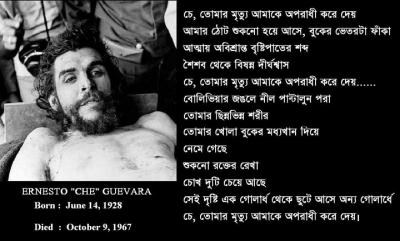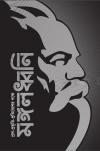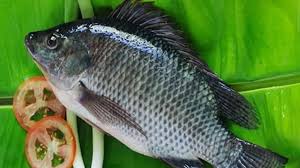THE DEATH OF CHE GUEVARA: A CHRONOLOGY
OCTOBER 3, 1965: In a public speech, Fidel Castro reads a "Farewell" letter written by Che in April, in which Che resigns from all of his official positions within the Cuban government. The letter, which Che apparently never intended to be made public, states that "I have fulfilled the part of my duty that tied me to the Cuban revolution...and I say goodbye to you, to the comrades, to your people, who are now mine." (CIA Intelligence Memorandum, "Castro and Communism: The Cuban Revolution in Perspective," 5/9/66)
OCTOBER 18, 1965: A CIA Intelligence Memorandum discusses what analysts perceive as Che Guevara's fall from power within the Cuban government beginning in 1964. It states that at the end of 1963, Guevara's plan of "rapid industrialization and centralization during the first years of the Revolution brought the economy to its lowest point since Castro came to power." "Guevara's outlook, which approximated present-day Chinese—rather than Soviet—economic practice, was behind the controversy." In July 1964, "two important cabinet appointments signaled the power struggle over internal economic policy which culminated in Guevara's elimination." Another conflict was that Guevara wanted to export the Cuban Revolution to different parts of Latin America and Africa, while "other Cuban leaders began to devote most of their attention to the internal problems of the Revolution." In December, 1964, Guevara departed on a three-month trip to the United States, Africa, and China. When he returned, according to the CIA report, his economic and foreign policies were in disfavor and he left to start revolutionary struggles in other parts of the world. (CIA Intelligence Memorandum, "The Fall of Che Guevara and the Changing Face of the Cuban Revolution," 10/18/65)
FALL, 1966: Che Guevara arrives in Bolivia sometime between the second week of September and the first of November of 1966, according to different sources. He enters the country with forged Uruguayan passports to organize and lead a communist guerrilla movement. Che chooses Bolivia as the revolutionary base for various reasons. First, Bolivia is of lower priority than Caribbean Basin countries to US security interests and poses a less immediate threat, "... the Yanquis wouldn't concern themselves... ." Second, Bolivia's social conditions and poverty are such that Bolivia is considered susceptible to revolutionary ideology. Finally, Bolivia shares a border with five other countries, which would allow the revolution to spread easily if the guerrillas are successful. (Harris, 60, 73; Rojo 193-194; Rodrfguez:1, 157;Rodrfguez:1, 198)
SPRING, 1967: From March to August of 1967, Che Guevara and his guerrilla band strike "pretty much at will" against the Bolivian Armed Forces, which totals about twenty thousand men. The guerrillas lose only one man compared to 30 of the Bolivians during these six months. (James, 250, NYT 9/16/67)
APRIL 28, 1967: General Ovando, of the Bolivian Armed Forces, and the U.S. Army Section signed a Memorandum of Understanding with regard to the 2nd Ranger Battalion of the Bolivian Army "which clearly defines the terms of U.S.-Bolivian Armed Forces cooperation in the activation, organization, and training of this unit."
MAY 11, 1967: Walt Rostow, presidential advisor to Lyndon B. Johnson, sends a message to the President saying that he received the first credible report that "Che" Guevara is alive and operating in South America, although more evidence is needed. (Rostow 05/11/67)
JUNE, 1967: Cuban-American CIA agent Félix Rodríguez receives a phone call from a CIA officer, Larry S., who proposes a special assignment for him in South America in which he will use his skills in unconventional warfare, counter-guerrilla operations and communications. The assignment is to assist the Bolivians in tracking down and capturing Che Guevara and his band. His partner will be "Eduardo González" and Rodríguez is to use the cover name "Félix Ramos Medina." (Rodriguez:1, 148)
JUNE 26-30, 1967: Soviet Premier Aleksey Kosygin visits Cuba for discussions with Fidel Castro. According to a CIA intelligence cable, the primary purpose of his "trip to Havana June 26-30, 1967 was to inform Castro concerning the Middle East Crisis...A secondary but important reason for the trip was to discuss with Castro the subject of Cuban revolutionary activity in Latin America." The Soviet Premier criticizes the dispatch of Che Guevara to Bolivia and accuses Castro of "harming the communist cause through his sponsorship of guerrilla activity...and through providing support to various anti-government groups, which although they claimed to be "socialist" or communist, were engaged in disputes with the "legitimate" Latin American communist parties, those favored by the USSR." In reply Castro stated that Cuba will support the "right of every Latin American to contribute to the liberation of his country." (CIA Intelligence Information Cable, 10/17/67)
AUGUST 2, 1967: Rodríguez and González arrive in La Paz, Bolivia. They are met by their case officer, Jim, another CIA agent, and a Bolivian immigration officer. The CIA station in La Paz is run by John Tilton; eventually the CIA's Guevara task force is joined by another anti-Castro Cuban-American agent, Gustavo Villoldo. (Rodrfguez:1, 162)
AUGUST 31, 1967: The Bolivian army scores its first victory against the guerrillas, wiping out one-third of Che's men. José Castillo Chávez, also known as Paco, is captured and the guerrillas are forced to retreat. Che's health begins to deteriorate. (James, 250, 269)
SEPTEMBER 3, 1967: Félix Rodríguez flies with Major Arnaldo Saucedo from Santa Cruz to Vallegrande to interrogate Paco. (Rodriguez:1, 167)
SEPTEMBER 15, 1967: The Bolivian Government air-drops leaflets offering a $4,200 reward for the capture of Che Guevara. (NYT 9/16/67)
SEPTEMBER 18, 1967: Fifteen members of a Communist group, who were providing supplies to the guerrillas in the southeastern jungles of Bolivia, are arrested. (NYT 9/19/67)
SEPTEMBER 22, 1967: Che's guerrillas arrive at Alto Seco village in Bolivia. Inti Peredo, a Bolivian guerrilla, gives the villagers a lecture on the objectives of the guerrilla movement. The group leaves later that night after purchasing a large amount of food. (Harris, 123)
According to Jon Lee Anderson's account, Che takes the food from a grocery store without paying for it after discovering that the local authorities in Alto Seco have left to inform the army about the guerrilla's position. (Anderson, 785)
SEPTEMBER 22, 1967: Guevara Arze, the Bolivian Foreign Minister, provides evidence to the Organization of American States to prove that Che Guevara is indeed leading the guerrilla operations in Bolivia. Excerpts taken from captured documents, including comparisons of handwriting, fingerprints and photographs, suggests that the guerrillas are comprised of Cubans, Peruvians, Argentineans and Bolivians. The foreign minister's presentation draws a loud applause from the Bolivian audience, and he gives his assurance that "we're not going to let anybody steal our country away from us. Nobody, at any time." (NYT 9/23/67)
SEPTEMBER 24, 1967: Che and his men arrive, exhausted and sick, at Loma Larga, a ranch close to Alto Seco. All but one of the peasants flee upon their arrival. (Harris, 123)
SEPTEMBER 26, 1967: The guerrillas move to the village of La Higuera and immediately notice that all the men are gone. The villagers have previously been warned that the guerrillas are in the area and they should send any information on them to Vallegrande. The remaining villagers tell the guerrillas that most of the people are at a celebration in a neighboring town called Jahue. (Harris, 123)
1 p.m.: As they are about to depart for Jahue, the rebels hear shots coming from the road and are forced to stay in the village and defend themselves. Three guerrillas are killed in the gun battle: Roberto (Coco) Peredo, a Bolivian guerrilla leader who was one of Che's most important men; "Antonio," believed to be Cuban; and "Julio," likely a Bolivian. Che orders his men to evacuate the village along a road leading to Rio Grande. The army high command and the Barriento's government consider this encounter a significant victory. Indeed, Che notes in his diary that La Higuera has caused great losses for him in respect to his rebel cell. (Harris 123,124; NYT 9/28/67))
CIA agent, Félix Rodríguez, under the alias, "Captain Ramos," urges Colonel Zenteno to move his Rangers battalion from La Esperanza headquarters to Vallegrande. The death of Antonio, the vanguard commander [also called Miguel by Rodríguez], prompts Rodríguez to conclude that Che must be close by. Colonel Zenteno argues that the battalion has not yet finished their training, but he will move them as soon as this training is complete. Convinced that he knows Che's next move, Rodríguez continues pressuring Zenteno to order the 2nd Ranger battalion into combat. (Rodrfguez:1, 184)
SEPTEMBER 26-27, 1967: After the battle of La Higueras, the Ranger Battalion sets up a screening force along the river San Antonio to prevent exfiltration of the guerrilla force. During the mission, the troops captures a guerrilla known as "Gamba." He appears to be in poor health and is poorly clothed. This produces an immediate morale effect on the troops because they notice that the guerrillas are not as strong as they thought. "Gamba" says that he had separated from the group and was traveling in hope of contacting "Ramón" (Guevara). (Dept. of Defense Intelligence Information Report— 11/28/67).
SEPTEMBER 29, 1967: Colonel Zenteno is finally persuaded by Rodríguez, and he moves the 2nd Ranger battalion to Vallegrande. Rodríguez joins these six hundred and fifty men who have been trained by U.S. Special Forces Major "Pappy" Shelton. (Rodrfguez:1, 184)
SEPTEMBER 30, 1967: Che and his group are trapped by the army in a jungle canyon in Valle Serrano, south of the Grande River. (NYT 10/1/67)
OCTOBER 7, 1967: The last entry in Che's diary is recorded exactly eleven months since the inauguration of the guerrilla movement. The guerrillas run into an old woman herding goats. They ask her if there are soldiers in the area but are unable to get any reliable information. Scared that she will report them, they pay her 50 pesos to keep quiet. In Che's diary it is noted that he has "little hope" that she will do so. (Harris, 126; CIA Weekly Review, "The Che Guevara Diary," 12/15/67)
Evening: Che and his men stop to rest in a ravine in Quebrada del Yuro. (Harris, 126)
OCTOBER 8, 1967: The troops receive information that there is a band of 17 guerrillas in the Churro Ravine. They enter the area and encounters a group of 6 to 8 guerrillas, opens fire, and killed two Cubans, "Antonio" and "Orturo." "Ramon" (Guevara) and "Willy" try to break out in the direction of the mortar section, where Guevara is wounded in the lower calf. (Dept. of Defense Intelligence Information Report— 11/28/67)
OCTOBER 8, 1967: A peasant women alerts the army that she heard voices along the banks of the Yuro close to the spot where it runs along the San Antonio river. It is unknown whether it is the same peasant woman that the guerrillas ran into previously. (Rojo 218)
By morning, several companies of Bolivian Rangers are deployed through the area that Guevara's Guerrillas are in. They take up positions in the same ravine as the guerrillas in Quebrada del Yuro. (Harris,126)
About 12 p.m.: A unit from General Prado's company, all recent graduates of the U.S. Army Special Forces training camp, confronts the guerrillas, killing two soldiers and wounding many others. (Harris, 127)
1:30 p.m.: Che's final battle commences in Quebrada del Yuro. Simon Cuba (Willy) Sarabia, a Bolivian miner, leads the rebel group. Che is behind him and is shot in the leg several times. Sarabia picks up Che and tries to carry him away from the line of fire. The firing starts again and Che's beret is knocked off. Sarabia sits Che on the ground so he can return the fire. Encircled at less than ten yards distance, the Rangers concentrate their fire on him, riddling him with bullets. Che attempts to keep firing, but cannot keep his gun up with only one arm. He is hit again on his right leg, his gun is knocked out of his hand and his right forearm is pierced. As soldiers approach Che he shouts, "Do not shoot! I am Che Guevara and worth more to you alive than dead." The battle ends at approximately 3:30 p.m. Che is taken prisoner. (Rojo, 219; James, 14)
Other sources claim that Sarabia is captured alive and at about 4 p.m. he and Che are brought before Captain Prado. Captain Prado orders his radio operator to signal the divisional headquarters in Vallegrande informing them that Che is captured. The coded message sent is "Hello Saturno, we have Papa!" Saturno is the code for Colonel Joaquin Zenteno, commandant of the Eighth Bolivian Army Division, and Papa is code for Che. In disbelief, Colonel Zenteno asks Capt. Prado to confirm the message. With confirmation, "general euphoria" erupts among the divisional headquarters staff. Colonel Zenteno radios Capt. Prado and tells him to immediately transfer Che and any other prisoners to La Higuera. (Harris, 127)
In Vallegrande, Félix Rodríguez receives the message over the radio: "Papá cansado," which means "Dad is tired." Papa is the code for foreigner, implying Che. Tired signifies captured or wounded. (Rodriguez:1, 185)
Stretched out on a blanket, Che is carried by four soldiers to La Higuera, seven kilometers away. Sarabia is forced to walk behind with his hands tied against his back. Just after dark the group arrives in La Higuera and both Che and Sarabia are put into the school's one-room schoolhouse. Later that night, five more guerrillas are brought in. (Harris, 127)
Official army dispatches falsely report that Che is killed in the clash in southeastern Bolivia, and other official reports confirm the killing of Che and state that the Bolivian army has his body. However, the army high command does not confirm this report. (NYT 10/10/67)
OCTOBER 9, 1967: Walt Rostow sends a memorandum to the President with tentative information that the Bolivians have captured Che Guevara. The Bolivian unit engaged in the operation was the one that had been trained by the U.S. (Rostow 10/9/67)
OCTOBER 9, 1967: 6:15 a.m.: Félix Rodríguez arrives by helicopter in La Higuera, along with Colonel Joaquín Zenteno Anaya. Rodríguez brings a powerful portable field radio and a camera with a special four-footed tripod used to photograph documents. He quietly observes the scene in the schoolhouse, and records what he sees, finding the situation "gruesome" with Che lying in dirt, his arms tied behind his back and his feet bound together, next to the bodies of his friends. He looks "like a piece of trash" with matted hair, torn clothes, and wearing only pieces of leather on his feet for shoes. In one interview, Rodríguez states that, " I had mixed emotions when I first arrived there. Here was the man who had assassinated many of my countrymen. And nevertheless, when I saw him, the way he looked....I felt really sorry for him." (Rodrfguez:2)
Rodríguez sets up his radio and transmits a coded message to the CIA station in either Peru or Brazil to be retransmitted to Langley headquarters. Rodríguez also starts to photograph Che's diary and other captured documents. Later, Rodríguez spends time talking with Che and takes a picture with him. The photos that Rodríguez takes are preserved by the CIA. (Anderson, 793; Rodrfguez:1, 193)
10 am: The Bolivian officers are faced with the question of what to do with Che. The possibility of prosecuting him is ruled out because a trial would focus world attention on him and could generate sympathetic propaganda for Che and for Cuba. It is concluded that Che must be executed immediately, but it is agreed upon that the official story will be that he died from wounds received in battle. Félix Rodríguez receives a call from Vallegrande and is ordered by the Superior Command to conduct Operation Five Hundred and Six Hundred. Five hundred is the Bolivian code for Che and six hundred is the order to kill him. Rodríguez informs Colonel Zenteno of the order, but also tells him that the U.S. government has instructed him to keep Che alive at all costs. The CIA and the U.S. government have arranged helicopters and airplanes to take Che to Panama for interrogation. However, Colonel Zenteno says he must obey his own orders and Rodríguez decides, "to let history take its course," and to leave the matter in the hands of the Bolivians. (Anderson, 795; Harris 128, 129; Rodrfguez:1, 193; Rodrfguez:2)
Rodríguez realizes that he cannot stall any longer when a school teacher informs him that she has heard a news report on Che's death on her radio. Rodríguez enters the schoolhouse to tell Che of the orders from the Bolivian high command. Che understands and says, "It is better like this ... I never should have been captured alive." Che gives Rodríguez a message for his wife and for Fidel, they embrace and Rodríguez leaves the room. (Rodrfguez:2; Anderson, 796)
According to one source, the top ranking officers in La Higuera instruct the noncommissioned officers to carry out the order and straws are drawn to determine who will execute Che. Just before noon, having drawn the shortest straw, Sergeant Jaime Terán goes to the schoolhouse to execute Che. Terán finds Che propped up against the wall and Che asks him to wait a moment until he stands up. Terán is frightened, runs away and is ordered back by Colonel Selich and Colonel Zenteno. "Still trembling" he returns to the schoolhouse and without looking at Che's face he fires into his chest and side. Several soldiers, also wanting to shoot Che, enter the room and shoot him. (Harris, 129)
Félix Rodríguez has stated that, "I told the Sargento to shoot....and I understand that he borrowed an M-2 carbine from a Lt. Pérez who was in the area." Rodríguez places the time of the shooting at 1:10 p.m. Bolivian time. (Rodrfguez:2)
In Jon Lee Anderson's account, Sergeant Terán volunteers to shoot Che. Che's last words, which are addressed to Terán, are "I know you've come to kill me. Shoot, you are only going to kill a man." Terán shoots Che in the arms and legs and then in Che's thorax, filling his lungs with blood. (Anderson, 796)
OCTOBER 9, 1967: Early in the morning, the unit receives the order to execute Guevara and the other prisoners. Lt. Pérez asks Guevara if he wishes anything before his execution. Guevara replies that he only wishes to "die with a full stomach." Pérez asks him if he is a "materialist" and Guevara answers only "perhaps." When Sgt. Terran (the executioner) enters the room, Guevara stands up with his hands tied and states, "I know what you have come for I am ready." Terran tells him to be seated and leaves the room for a few moments. While Terran was outside, Sgt. Huacka enters another small house, where "Willy" was being held, and shoots him. When Terran comes back, Guevara stands up and refuses to be seated saying: "I will remain standing for this." Terran gets angry and tells Guevara to be seated again. Finally, Guevara tells him: "Know this now, you are killing a man." Terran fires his M2 Carbine and kills him. (Dept. of Defense Intelligence Information Report— 11/28/67).
Later that afternoon: Senior army officers and CIA Agent, Félix Rodrfguez, leave La Higuera by helicopter for army headquarters in Vallegrande. Upon landing, Rodrfguez quickly leaves the helicopter knowing that Castro's people will be there looking for CIA agents. Pulling a Bolivian army cap over his face, he is not noticed by anyone. (Rodrfguez:1, 12; Harris, 130)
Che's body is flown to Vallegrande by helicopter and later fingerprinted and embalmed. (NYT 10/11/67)
General Ovando, Chief of Bolivian Armed Forces, states that just before he died, Che said, "I am Che Guevara and I have failed." (James, 8)
OCTOBER 10, 1967: W.G. Bowdler sends a note to Walt Rostow saying that they do not know if Che Guevara was "among the casualties of the October 8 engagement." They think that there are no guerrilla survivors. By October 9, they thought two guerrilla were wounded and possibly one of them is Che. (Bowdler, The White House 10/10/67)
OCTOBER 10, 1967: Two doctors,. Moises Abraham Baptista and JosT Martfnez Cazo, at the Hospital Knights of Malta, Vallegrande, Bolivia, sign a death certificate for Che Guevara. The document states that "on October 9 at 5:30 p.m., there arrived...Ernesto Guevara Lynch, approximately 40 years of age, the cause of death being multiple bullet wounds in the thorax and extremities. Preservative was applied to the body." On the same day, and autopsy report records the multiple bullets wounds found in Guevara's body. "The cause of death," states the autopsy report, "was the thorax wounds and consequent hemorrhaging." (U.S. Embassy in La Paz, Bolivia, Airgram, 10/18/67)
OCTOBER 10, 1967: General Ovando announces that Che died the day before at 1:30 p.m. This means that Che lived for twenty-two hours after the battle in Quebrada del Yuro, which contradicts Colonel Zenteno's story. Colonel Zenteno changes his story to support General Ovando's. (James, 15)
The New York Times reports that the Bolivian Army High Command dispatches officially confirm that Che was killed in the battle on Sunday October 8th. General Ovando states that Che admitted his identity and the failure of his guerrilla campaign before dying of his wounds. (NYT 10/10/67)
Ernesto Guevara, the father of Che, denies the death of his son, stating that there is no evidence to prove the killing. (NYT 10/11/67)
OCTOBER 11, 1967: General Ovando claims that on this day Che's body is buried in the Vallegrande area. (James, 19)
OCTOBER 11, 1967: President Lyndon Johnson receives a memorandum from Walt W. Rostow: "This morning we are about 99% sure that "Che" Guevara is dead." The memo informs the President that according to the CIA, Che was taken alive and after a short interrogation General Ovando ordered his execution. (Rostow, "Death of Che Guevara," 10/11/67)
OCTOBER 11, 1967: Walt Rostow sends a memorandum to the President stating that they "are 99% sure that "Che" Guevara is dead." He explains that Guevara's death carries significant implications: "It marks the passing of another of the aggressive, romantic revolutionaries...In the Latin American context, it will have a strong impact in discouraging would-be guerrillas. It shows the soundness of our "preventive medicine" assistance to countries facing incipient insurgency—it was the Bolivian 2nd Ranger Battalion, trained by our Green Berets from June-September of this year, that cornered him and got him." (Rostow 10/11/67)
OCTOBER 12, 1967: Che's brother, Roberto, arrives in Bolivia to take the body back to Argentina. However, General Ovando tells him that the body has been cremated. (Anderson, 799)
OCTOBER 13, 1967: Walt Rostow sends a note to the President with intelligence information that "removes any doubt that "Che" Guevara is dead." (Rostow 10/13/67)
OCTOBER 14, 1967: Annex No.3— three officials of the Argentine Federal police, at the request of the Bolivian Government, visited Bolivian military headquarters in La Paz to help identify the handwriting and fingerprints of Che Guevara. "They were shown a metal container in which were two amputated hands in a liquid solution, apparently formaldehyde." The experts compared the fingerprints with the ones in Guevara's Argentine identity record, No. 3.524.272, and they were the same. (U.S. Embassy in La Paz, Bolivia, Airgram, 10/18/67)
OCTOBER 14, 1967: Students at Central University of Venezuela protest the U.S. involvement in Che's death. Demonstrations are organized against a U.S. business, the home of a U.S. citizen, the U.S. Embassy and other similar targets.
OCTOBER 15, 1967: Bolivian President Barrientos claims that Che's ashes are buried in a hidden place somewhere in the Vallegrande region. (Harris, 130)
OCTOBER 16, 1967: The Bolivian Armed Forces released a communiqué together with three annexes on the death of Che Guevara. The communiqué is "based on documents released by the Military High Command on October 9...concerning the combat that took place at La Higuera between units of the Armed Forces and the red group commanded by Ernesto "Che" Guevara, as a result of which he, among others, lost his life..." The report states that Guevara died "more or less at 8 p.m. on Sunday, October 8...as a result of his wounds." Also, in order to identify his body it requested the cooperation of Argentine technical organizations to identify the remains to certify that the handwriting of the campaign diary coincides with Guevara's. Henderson, the U.S. Embassy agent in La Paz, comments that "it will be widely noted that neither the death certificate nor the autopsy report state a time of death." This "would appear to be an attempt to bridge the difference between a series of earlier divergent statements from Armed Forces sources, ranging from assertions that he died during or shortly after battle to those suggesting he survived at least twenty-four hours." He also notes that some early reports indicate that Guevara was captured with minor injuries, while later statements , including the autopsy report, affirm that he suffered multiple wounds. He agrees with a comment by PresTncia, that these statements are "going to be the new focus of polemics in the coming days." (U.S. Embassy in La Paz, Bolivia, Airgram, 10/18/67)
OCTOBER 18, 1967: The U.S. Embassy in La Paz, Bolivia sends an airgram to the Department of State with the Official Confirmation of Death of Che Guevara. (U.S. Embassy, La Paz, Bolivia, 10/18/97)
OCTOBER 18, 1967: A CIA cable highlights the errors leading to Guevara's defeat. "There were negative factors and tremendous errors involved in the death of Ernesto "Che" Guevara Serna and the defeat of the guerrillas in Bolivia... ." Che's presence at the guerrilla front in Bolivia, " ... precluded all hope of saving him and the other leaders in the event of an ambush and virtually condemned them to die or exist uselessly as fugitives." The fact that the guerrillas were so dependent on the local peasant population also proved to be a mistake according to the CIA. Another error described in this cable is Che's over-confidence in the Bolivian Communist Party, which was relatively new, inexperienced, lacking strong leadership and was internally divided into Trotskyite and Pro-Chinese factions. Finally, the cable states that the victory of the Bolivian army should not be credited to their actions, but to the errors of Castroism. "The guerrilla failure in Bolivia is definitely a leadership failure..."("Comments on the death of Ernesto "Che" Guevara Serna," 10/18/67)
OCTOBER 18, 1967: Fidel Castro delivers a eulogy for Che Guevara to nearly a million people —one of his largest audiences ever—in Havana's Plaza de la Revolución. Castro proclaims that Che's life-long struggle against imperialism and his ideals will be the inspiration for future generations of revolutionaries. His life was a "glorious page of history" because of his extraordinary military accomplishments, and his unequaled combination of virtues which made him an "artist in guerrilla warfare." Castro professes that Che's murderers" will be disappointed when they realize that "the art to which he dedicated his life and intelligence cannot die." (Anderson, 798; Castro's Eulogy, 10/18/97)
OCTOBER 19, 1967: Intelligence and Research's Cuba specialist, Thomas L. Hughes, writes a memorandum to Secretary of State, Dean Rusk. Hughes outlines two significant outcomes of Che Guevara's death that will affect Fidel Castro's future political strategies. One is that "Guevara will be eulogized as the model revolutionary who met a heroic death," particularly among future generations of Latin American youth. Castro can utilize this to continue justifying his defiance of the usual suspects—"US imperialism, the Green Berets, the CIA." Another outcome is that Castro will reassess his expectations of exporting revolutions to other Latin American countries. Some Latin American leftists "will be able to argue that any insurgency must be indigenous and that only local parties know when local conditions are right for revolution." (Intelligence and Research Memorandum, "Guevara's Death—The Meaning for Latin America", 10/19/97)
NOVEMBER 8, 1967: The CIA reports that Cuba is threatening assassin a prominent Bolivian figure, such as President Barrientos or General Ovando, in revenge of Che Guevara's death. ( CIA cable, 11/8/67)
JULY 1, 1995: In an interview with biographer Jon Lee Anderson, Bolivian General Mario Vargas Salinas reveals that "he had been a part of a nocturnal burial detail, that Che's body and those of several of his comrades were buried in a mass grave near the dirt airstrip outside the little mountain town of Vallegrande in Central Bolivia." A subsequent Anderson article in the New York Times sets off a two-year search to find and identify Guevara's remains. (Anderson,1)
JULY 5, 1997: Che Guevara biographer, Jon Lee Anderson, reports for the New York Times that although the remains have not been exhumed and definitely identified, two experts are "100 percent sure" that they have discovered Che's remains in Vallegrande. The fact that one of the skeletons is missing both of its hands is cited as the most compelling evidence. (NYT 7/5/97) [Bones Now Seem to Prove That Che Is Dead JON LEE ANDERSON / New York Times 5jul1997]
JULY 13, 1997: A ceremony in Havana, attended by Fidel Castro and other Cuban officials, marks the return of Che's remains to Cuba. (NYT 7/14/97)
OCTOBER 17, 1997: In a ceremony attended by Castro and thousands of Cubans, Che Guevara is reburied in Santa Clara, Cuba. (NYT, 10/18/97)

Death to Capitalism...
Death to Terrorism...
Death to Israel...
Long Live Comrade Karl Marx.....
Long Live Comrade Lelin.....
Long Live Comrade Chairman Mao.....
Long Live Comrade Ho Chi Minh.....
Long Live Comrade Fidel Castro.....
Long Live Comrade Che Guevara.....
Long Live Comrade Hugo Chavez.....
Long Live Revolution............................
Red Salute to all Comrades around the World..............
---------------------------------------
"ওদের সঙ্গে যুদ্ধ করতে করতে আমার প্রিয় এম-২ রাইফেলটা অকেজো হয়ে গেছে। তবে আমার পরাজয় এই নয় যে, বিজয় অর্জন সম্ভব নয়। এভারেস্ট বিজয়ের অভিযানেও অনেকে পরাজিত হয়েছিলেন। কিন্তু সেটা আজ মানুষ জয় করেছে। ফিদেলকে বলো_ আমার মৃত্যুতে বিপ্লব পরাজিত হয়নি। বিপ্লবের মৃত্যু নেই। শোষিত মানুষের জয় অনিবার্য। পুঁজিবাদ-সাম্রাজ্যবাদ একদিন ধ্বংস হবেই। বিদায়......."--চে


 অনুগ্রহ করে অপেক্ষা করুন। ছবি আটো ইন্সার্ট হবে।
অনুগ্রহ করে অপেক্ষা করুন। ছবি আটো ইন্সার্ট হবে।







১. ০৯ ই অক্টোবর, ২০১০ সকাল ১১:৩৬ ০